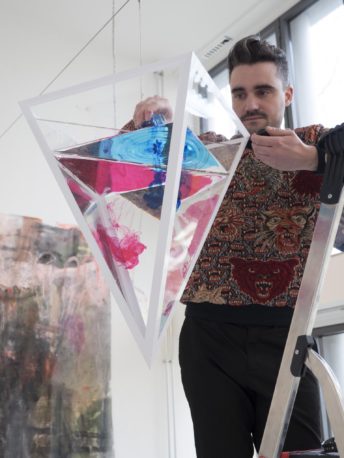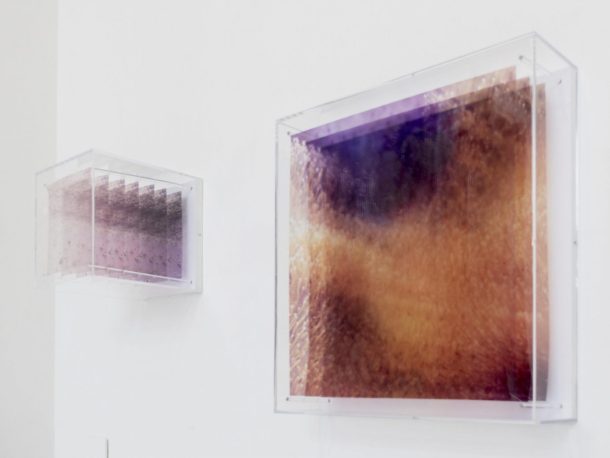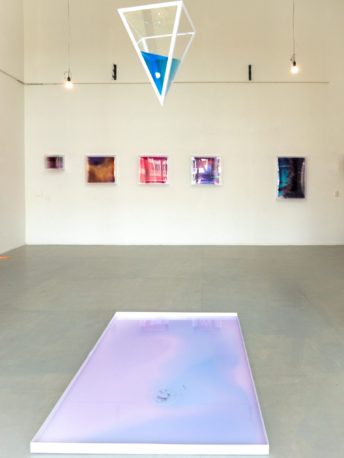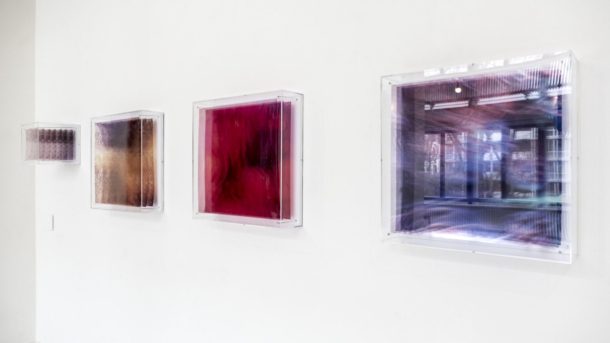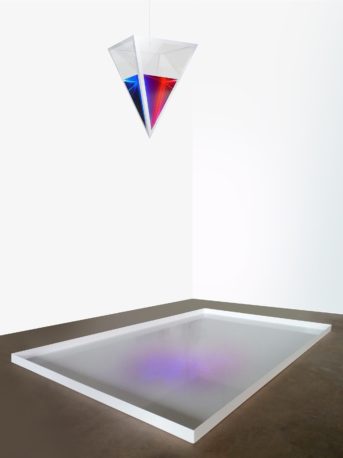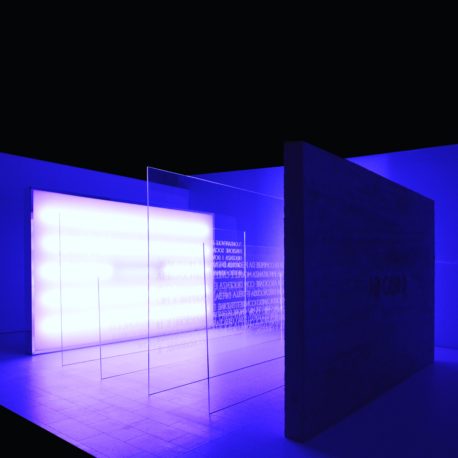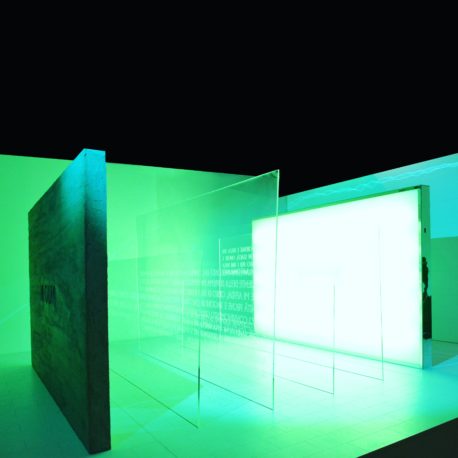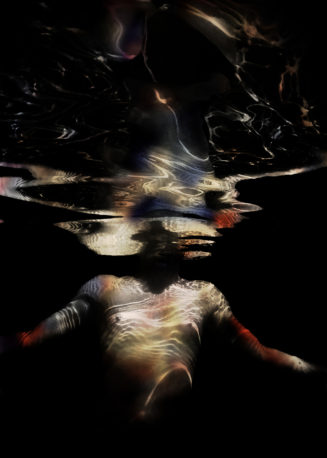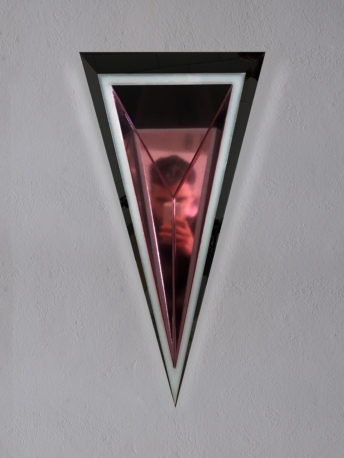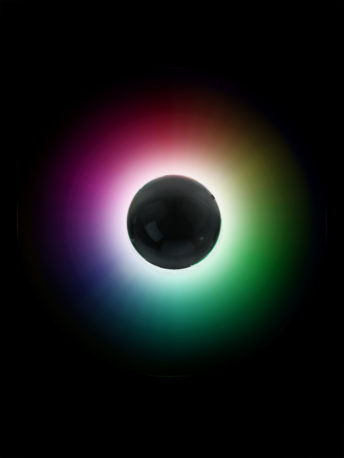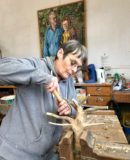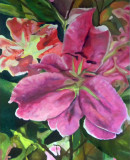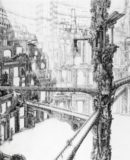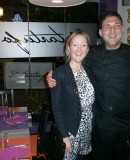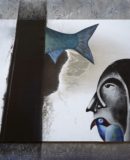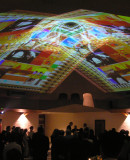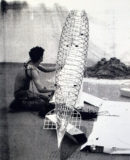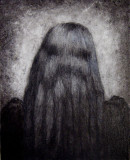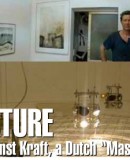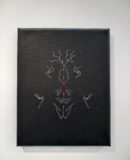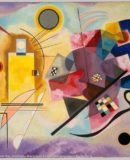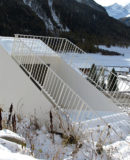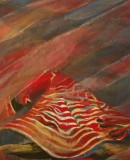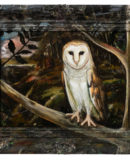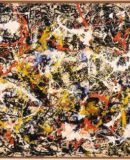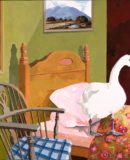World Fine Art Professionals and their Key-Pieces, 216 - David Lascaris
World Fine Art Professionals and their Key-Pieces, 216 – David Lascaris
In Breed Art Studio I saw the work of the artists Roland Berning and David Lascaris in the exhibition FLUSSO FLUIDO (flowing liquid). Both artists place the concept of freedom at the center in the context of space and time.
With David Lascaris, space is a physical and existential thing that develops through the use of different media. On the wall of the gallery, for example, there were ‘Apneas’, boxes made of Plexiglas in which you can see a colorful image that changes as you walk past it. The image seems to melt in a colored liquid like in an aquarium. The image is based on layers of underwater photos printed on transparent acetate sheets.
Gender identity
The installation ‘Fluido di genere’ (gender fluid) was in the middle of the gallery space. Drops fall into a basin filled with water from an inverted pyramid on the ceiling that is half filled with red liquid and half with blue liquid.
David Lascaris is originally from Dolceacqua, in Liguria, two hours from Genoa. “Monet painted Dolceacqua three times. Few people who know that.” I speak to him in the cafe of the Krasnapolsky Hotel on Dam Square in Amsterdam. He says about ‘Fluido di genere’: “The result is different every time. Usually the blue and red mix into a kind of purple. But in Luca Rezzolla’s gallery, the colors didn’t mix, they remained separate. It is not predictable.” With the installation, Lascaris wanted to comment on the concept of gender identity. “People have a strong tendency to put other people in boxes, but the reality is fluid, also in terms of gender.”
The eternal and the ephemeral
David Lascaris focuses on the transition from the unconscious and the eternal to the ephemeral and the fleeting. “My ideas are often fleeting, uncertain. Time and time course often come back. I often choose transparent material or material that is subject to wear. In my latest artworks, I incorporate visual or physical instability into the artwork itself, showing the unpredictability of reality. For example in the installation ‘Fluido di genere’. “
He is fascinated by the theme of life and death and the relationship between the human and the divine. The Chilean Alejandro Jodorowsky wrote about this in his biography ‘The Dance of Reality’. “I read that book with increasing interest. In his stories about dream journeys, I recognized my own dreams and my own nightmares. It has influenced my perception of a number of themes. “
Another artist who inspires him is Bill Viola. “Just like him, I am obsessed with the water world that turns out to be a new world with its own dimensions. You can dive into it and experience its unworldly, spiritual effect. “
Beijing
In 2012, in connection with the completion of his architectural studies, he spent a year in China, in Beijing. He experienced fragility, temporality and immateriality, as he calls it. “In China and Beijing in particular, everything is immediate, and everything is changeable. On the one hand, there is an exponentially growing reality based on the way we do urban planning in the West. On the other hand, there is the more authentic reality of the Hutong, the houses with narrow alleys and courtyards that originate from the siheyuan, the traditional courtyards in Beijing. But that cultural heritage is slowly threatening to die. “
In the hutong, life is somehow immaterial, he experienced. “I have experienced it myself. The houses are crowded, often without a kitchen and with toilets outside. Although the wall is one of the fundamental elements in the grammar of the Chinese city, the dividing line between public and private space is often crossed and the alley becomes an extension of the domestic dimension. It’s easy to meet people in pajamas or see people washing their hair in the street. Lunch and chats are made on the sidewalk. When it is dinner time, the street becomes full of tables and chairs, and after that the elderly people hang out among a few parked wagons or play mahjong on a garbage can. Even commercial matters are dominated by improvisation: wooden huts where you can rent a bike or have it repaired, shoemakers, hairdressers, dentists, pancake and dumplings sellers. And everywhere you see sofas, armchairs, stools, mobile kitchens and camping stoves. “
The ‘chai sign’
Everything happens on the street. “Everything continuously acquires a temporary meaning, it shows a city in constant evolution. Only a small percentage of those traditional neighborhoods have remained intact. On many walls you see the ‘chai sign’ in red letters, the symbol of destruction. The relevant house or block will be demolished. In its place there will be higher and more closely related complexes, the residents have to move to the periphery of the city. But that rebuilding sometimes does not come to a good end and what you then see is a situation of destruction. Debris, open roofs, destroyed walls, abandoned bicycles, wild vegetation, broken paths, erased identities … But still the laundry hangs to dry between one ruin and the other. The earthquake victims without an earthquake continue to live in the neighborhood where their home once stood. “
Transparent
As a result of this experience, his ideas that he wants to work out in his art are often short-lived, fleeting, and in a way uncertain. Time and duration became recurring themes. He often opts for materials that provide transparency or that evaporate. “Many works are being transformed, evolving, seemingly moving, as in the case of ‘Apnea’ during the ‘Flusso Fluido’ exhibition.”
David Lascaris: “The photographed reality reveals that its transience becomes ethereal and transparent. Depending on the movement of the viewer, the shapes are more or less defined, they emerge from the unclear unity and then return to it as soon as the viewpoint changes. The light, which passes through the work, projects a colored light-emitting nimbus (‘halo’) on the wall so that the liquid image exceeds the limits imposed a priori. Here, too, spatiality is important: the two-dimensional nature of the photographic image becomes a three-dimensional space, not in an illusionistic way through trompe l’oeil effect or breakthroughs in perspective, but through the accumulation of elements that are always the same. ”
Immersion of the eye
However, the image is not linked to the three-dimensional dimension. “The eye is immersed in something that is distorted. It goes to a heterotopic (conflicting) space with infinite possibilities and endless overlaps. The image that should be captured in an unchanging moment by photography is instead dematerialized, dissolved: it is subject to constant manipulation through the insertion of the temporal element, a movement that seems to belong to it, but that the viewer fills in. The space reveals the nature of relationships, of space between things, which involves movement and time. The surface of the acetate thus becomes a membrane that separates this and that other dimension, in a continuous overlap of virtual but also real places. “
Key work
Does David have a key work, an important, directional work? He has two. The first is ‘Io Giuro’ (I take an oath). ‘Io Giuro’ is a project that he developed in 2016 together with the artist Andrea Fazio. They entered the final of a competition that was launched for a proposal for a site-specific installation for the Palace of Justice in Florence. “We made a sculpture of the installation project in a reduced version of 100x250x180cm, now owned by the municipality of Florence.”
On a surface of 5×5 meters, six walls are placed parallel to each other at a distance of 1 meter: a light wall, four transparent walls and a concrete wall. The theme is Justice: on the glass elements are the words of the oaths that the people who operate in the world of law must pronounce, engraved with a laser beam.
The light wall projects the shadow of these words onto the spectators and onto the concrete wall as to make them ‘eternal’, by attaching an abstract and immaterial concept, powerful but at the same time fragile and ephemeral (they are in the air), to the solidity of the stone.
The site-specific installation is designed as a gateway to the Palace of Justice in Florence.
Leonardo Ricci
The reflections of the words, the light and the colors radiate not only on the judge and the man being judged, but also the common man who walks through this passage every day. The shadow of the walkers is cast again on the oaths. In this way they become part of the installation, which is also the intention. “Justice is something of all of us, and not just those who say ‘Io Giuro’, ‘I take an oath’.
Lascaris: “Important for the development of the project was the relationship with the context of the Palazzo as conceived by the architect Leonardo Ricci. He viewed justice as something made by people for people and as an educational thing. People can enter this public building and become part of that ‘sacred space’ in which an aspect of the ‘human tragedy’ takes place. “
The passage is both a physical and a mental path. “On a mental level, walking along the light wall acts as an ‘initiation path’ of consciousness, the moment one becomes aware of the meaning of the oath.”
The light in the material
The light from the material is central to the construction of space and composition. “That is not to improve the architectural forms in a sculptural way, but to build with immaterial matter, inspired by James Turrell, but also by John Cage and Mies Van Der Rohe who built his Pavilion in Barcelona with matter-air.” This light space includes not only the area enclosed in the installation, but also the space around it, making the vertical and horizontal surfaces of the building an integral part of the work.
The second key work is the installation ‘Fluido di Genere’. We were already talking about it. The red and blue drops that fall down from an inverted pyramid into a basin. “People tend to think in boxes rather than from a reality that is fluid. This also applies to sexuality and gender. These are things that people cannot intervene in, people can only think about their unpredictability. The pyramid also functions as an hourglass, you can count down until it is completely empty, then the issue of gender is no longer relevant. “
From architect to artist
David Lascaris, a trained architect, acquired theoretical and practical design skills in the field of art and architecture during his studies. Through various work experiences, he subsequently immersed himself in various artistic realities, including in China. There he had his first group exhibition in the Hutopolis Pavilion of the Beijing Design Week. For two years, from 2015 to 2017, he worked in the Milanese studio of the artist Chiara Dynys. “It was very useful to realize that I had a different way to express myself, and to free myself from the limitations of architecture.” In 2017, he left for the Netherlands, Amsterdam, from where he had exhibitions in Italy and the Netherlands. The Iperuranio exhibition at the Fondamenta Gallery in Rome (March 2018), which focused on the ‘Fluido di genere’ installation, was his first personal exhibition.
In the meantime he is working on new work, including an underwater photography project with the title ‘Lingam’ and the ‘Invisibilia’ project with mirrors and moving images.
Philosophy
Finally: what is his philosophy? “Art is a way for me to give a voice to what I have on the inside. It cannot easily be expressed in words. In a materialistic society, where reality is only defined as tangible and measurable, there seems to be no room for some form of spirituality, which is very important to me. Death, life, transience, the ephemeral, but also the eternal and the divine. Those are the components of my work and of my projects. “
“When I give shape to an idea, it has a fascinating charm on me, but it also draws me into a kind of spider web, because it often has a scary component. For me, artistic action is a way of giving shape to something that I cannot communicate, that ‘misterium tremendum et fascinans’ that Rudolf Otto defined as the numinous (spiritual) experience. When I look inside, I actually look at a boundless dimension, something else, into which I am absorbed. I end up there and where do I have to go? What happens when I am there? I evoked something sublime and picturesque, to which I give a contemporary twist with heterogeneous materials and techniques, such as mirrors, light, glass, video, etc. ”
“One of my works entitled ‘Medusa’, which is shown in Rome at Galleria Triphé from 18 April 2019 to 18 June 2018, consists of a series of black triangular sculptures, in which the viewer must look inside through a reflective screen. Then he sees his face reflected in a mirror that is hidden in the sculpture. The reflection creates the illusion of a monster looking at us, but the monster’s eyes are your own, so you are the monster. Something fascinating can become threatening, deadly and disturbing and vice versa. ”
“The shape of the object is the stylization of a face and the viewer is obliged to make contact, to immerse himself in it to undergo the experience. He kisses himself and he kisses the other by himself, metaphorically speaking. “
Images
1) portrait David Lascaris, 2 – 4) Flusso Fluido 2019 Amsterdam Breedart Studios 2019 – plexiglass mirror – photo credits Luca Rezzolla, 5) Fluido di Genere – 2018 – 120x180x5cm – pyramid 60x40x40cm – plexiglass aluminum water color – photo credits David Lascaris, 6 – 7) I0 GIURO David Lascaris-Andrea Fazio 2016 cm100x250x180 stainless steel plexiglass wood concrete led light and shadow projection – detail – photo credits David Lascaris, 8) LINGAM 2018 photography glass shell cm70x40x10 – detail – photo credits David Lascaris, 9) MEDUSA 2019 – plexiglass mirror – photo credits David Lascaris, 10) SPECTRUM – 2019 – plexiglass mirror light – photo credits David Lascaris
https://www.saatchiart.com/davidlascaris
https://www.facebook.com/pages/category/Artist/David-Lascaris-698856353642071/
https://museumtijdschrift.nl/tentoonstellingen/roland-berning-en-david-lascaris-flussofluido/
https://breedartstudios.net/flussofluido/
https://ifthenisnow.eu/nl/verhalen/de-wereld-van-de-amsterdamse-kunstenaar-58-david-lascaris
Disclaimer: The views, opinions and positions expressed within this guest article are those of the author Walter van Teeffelen alone and do not represent those of the Marbella Marbella website. The accuracy, completeness and validity of any statements made within this article are not guaranteed. We accept no liability for any errors, omissions or representations. The copyright of this content belongs to Walter van Teeffelen and any liability with regards to infringement of intellectual property rights remains with the author.

